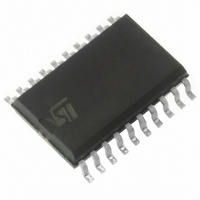TDA7338D STMicroelectronics, TDA7338D Datasheet - Page 7

TDA7338D
Manufacturer Part Number
TDA7338D
Description
IC DECODER STEREO SO-20
Manufacturer
STMicroelectronics
Type
Audio Decoderr
Datasheet
1.TDA7338D013TR.pdf
(12 pages)
Specifications of TDA7338D
Voltage - Supply, Digital
7.5 V ~ 10.2 V
Mounting Type
Surface Mount
Package / Case
20-SOIC (7.5mm Width)
Lead Free Status / RoHS Status
Lead free / RoHS Compliant
Applications
-
Voltage - Supply, Analog
-
Available stocks
Company
Part Number
Manufacturer
Quantity
Price
Part Number:
TDA7338D
Manufacturer:
ST
Quantity:
20 000
4.3.2 Noise Controlled Threshold Adjustment (ATC)
The behaviour of the noise controlled threshold adjustment is shown in fig. 8. It can be influenced lightly
by adding a resistor in parallel to the PEAK capacitor at Pin 8 either to GND or VDD. A resistor to GND
will decrease the threshold whereas a resistor to VDD will increase it. But it is recommended to choose
one of the internal thresholds by use of the PROG pin (see table 5)
4.3.3 Automatic Threshold Control by the Stereoblend voltage (ATC-SB)
Besides the noise controlled threshold adjustment there is an additional possibility for influencing the trig-
ger. It is controlled by the difference between Vsb and Vr, similar to the Stereoblend. The reason for im-
plementing such a second control will be explained in the following: The point where the MPX signal starts
to become noisy is fixed by the RF part. Therefore also the starting point of the normal noise controlled
trigger adjustment is fixed (fig.9). But in some cases the behaviour of the noiseblanker can be improved
by increasing the threshold even in a region of higher fieldstrength, for the MPX signal often shows distor-
tion in this range, which leads to an undesired triggering.
Because of the overlap of this range and the range of the stereo/mono transition it can be controlled by
Vsb and Vr. This threshold increase is programmable (see fig. 9).
4.3.4 Blend Mode
Another possibility to avoid a disturbing triggering on modulation is to use the spikes on the fieldstrength
signal (LEVEL pin). But in the range of higher fieldstrength the signal saturates and no more spike detec-
tion is possible. For this reason the TDA7338 offers the "BLEND MODE". When "BLEND MODE" is acti-
vated a smooth transition between the LEVEL- and the MPX-signal is used to detect the spikes either on
LEVEL or on MPX.
In the lower fieldstrength range mainly the LEVEL-signal is used whereas in the higher range mainly the
MPX is used.
This switching is controlled also by the normal Stereoblend signal to avoid additional pins. "BLEND MODE
OFF" is activated by connecting the LEVEL pin to GND (LEVEL must be also connected to GND if not
used).
Figure 7. Block Diagram of the Noise Blanker
MPX IN
LEVEL
V SB
V R
ON/OFF
BLEND
0.1V
+
-
80KHz LP
ADDITIONAL THRESHOLD
CONTROL
BLEND
140KHz HP
120KHz HP
CONTROL
(ATC-SB)
D95AU368
SIGNAL PATH
AMP
RECT-PEAK
BUF
RECT
PEAK
C PEAK
THRESHOLD
AUTOMATIC
47nF
CONTROL
ADDITIONAL THRESHOLD
CONTROL on/off
ATC
THRESHOLD L/H
PEAK COMP
PEAK+VTH
C BLANK
+
-
330pF
REF.
BLANK COMP
+
-
RIGHT
LEFT
40µs
2V
7V
V
S
TDA7338
to OUTPUTS
PROG
7/12













